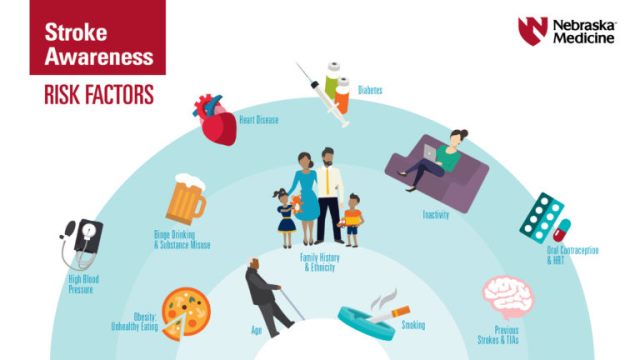10 lifestyle changes that can reduce your risk for stroke

Stroke may be more common than you may realize. More than 800,000 people have a stroke every year and about 200,000 of these cases are second-time strokes.
Now what if you knew that 90 percent of these strokes could have been prevented? Wouldn’t you want to know how? That’s the conclusion of a recent study that found nine in 10 strokes could be prevented by modifying 10 primary risk factors.
“Stroke is a leading cause of death and disability,” notes Marco Gonzalez, MD, neurologist at Nebraska Medicine. “In fact, it is the number one cause of long-term non-traumatic disability. While some risk factors, such as getting older and genetics can’t be changed, this study found that when these 10 controllable risk factors are modified, you can significantly reduce your risk for stroke.”

Lifestyle changes that can reduce your risk include:
- High blood pressure. Stroke risk is four to six times higher in those with high blood pressure. It is the biggest contributor to the risk of stroke in both men and women. One in three adults has high blood pressure. Get yours checked regularly and monitor it closely if it is high. Reducing salt intake, avoiding high-cholesterol foods, getting more exercise and quitting smoking will all help reduce high blood pressure.
- Exercise. Working out keeps your blood flowing and your heart strong. Aim for 30 minutes a day, five days a week. Even 10 minutes offers health benefits.
- Cholesterol. High levels of LDL or “bad” cholesterol and low levels of HDL or “good” cholesterol contribute to plaque build-up, which can clog arteries and lead to heart disease and stroke. Have yours checked at least once every five years.
- Diet. Study participants who ate a Mediterranean diet—rich in fish and fruits—had the lowest stroke risk. Load up on fruits, veggies, whole grains and lean proteins.
- Smoking. All forms of tobacco can cause blockages in the artery leading to the brain. Nicotine also raises blood pressure and thickens the blood, increasing the amount of plaque buildup in the arteries. When you kick the habit, your stroke risk drops immediately.
- Treat atrial fibrillation. Atrial fibrillation, a type of irregular heartbeat, can cause clots to form in the heart, which may travel to the brain, causing a stroke. Atrial fibrillation can make your risk by fivefold. Medications or surgery can treat atrial fibrillation.
- Diabetes. High blood sugar damages blood vessels in the brain making it easier for clots to form. People with diabetes have 1.5 times the risk for stroke compared with those without the disease. Work with your doctor to manage your blood glucose.
- Obesity. Being overweight contributes to high blood pressure, cholesterol, diabetes and heart disease. To maintain a healthy weight, balance the number of calories you eat with your physical activity level. Losing as little as 10 pounds can have a large impact on your stroke risk.
- Drinking alcohol. Binge drinking thins blood, increasing bleeding risk. Limit alcohol to one drink per day for women and two drinks for men. Make red wine your first choice, because it contains resveratrol, which is thought to protect the heart and brain.
- Stress. Constant psychological pressure may damage artery walls. To reduce stress, try positive self-talk. Don’t think, “I can’t do this.” Tell yourself, “I’ll do the best I can.”
Signs of a Stroke
The devastating effects of a stroke can be reduced if treatment is started right away. F.A.S.T is an easy way to remember the sudden signs of a stroke. If you suspect someone is having a stroke, call 911 for help right away.
- Face Drooping – Does one side of the face droop or is it numb? Ask the person to smile. Is the person’s smile uneven?
- Arm Weakness – Is one arm weak or numb? Ask the person to raise both arms. Does one arm drift downward?
- Speech Difficulty – Is speech slurred? Is the person unable to speak or hard to understand? Ask the person to repeat a simple sentence, like “The sky is blue.” Is the sentence repeated correctly?
- Time to call 911 – If someone shows any of these symptoms, even if the symptoms go away, call 911 and get the person to the hospital immediately. Check the time so you’ll know when the first symptoms appeared.
When Was the Last Time You Had a Physical?
To schedule an appointment with one of our doctors, call 800-922-0000.




